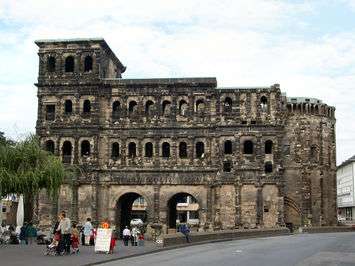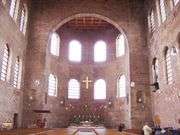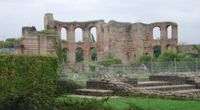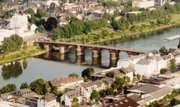

 I recently visited the city of Trier in Germany. The following is a short summary of information that might be helpful to a prospective visitor.
I recently visited the city of Trier in Germany. The following is a short summary of information that might be helpful to a prospective visitor.
Before I start, a quotation from a recent visitor to Trier: As a recent walking tour ended in front of Trier's ancient Porta Nigra gate, an Italian visitor stopped his guide and exclaimed, "This is even better than Rome!"
As Germany's oldest city, Trier contains the largest collection of ancient Roman buildings outside of Rome and it is a pedestrian-friendly area. In Trier, travellers can walk past and inside the Porta Nigra, the Roman Empire's largest intact city gate (photo to left).
 They can gaze in wonder at the size and majesty of the Basilika, used in the early 4th century by Emperor Constantine as an audience hall and throne room, and with the largest unsupported room of antiquity (photo to right).
They can gaze in wonder at the size and majesty of the Basilika, used in the early 4th century by Emperor Constantine as an audience hall and throne room, and with the largest unsupported room of antiquity (photo to right).
 They can explore the expansive ruins of the Imperial Baths, remodelled during the 4th century as a barracks for more than 1,000 soldiers.
Many of the walls still stand (photo to left).
They can explore the expansive ruins of the Imperial Baths, remodelled during the 4th century as a barracks for more than 1,000 soldiers.
Many of the walls still stand (photo to left).
They can see the foundation of Germany's oldest bridge, (photo to right) then as now a gateway to the Mosel vineyards first established by the Romans.

Visitors who sit on the Amphitheater's terraced seats can easily imagine the roar of 20,000 spectators, the snarls of tigers and the cries and groans of gladiators and prisoners of war. It was here that Romans gathered to watch animal fights as a prelude to fights between man and beast and, ultimately, man against man to the death. In the dank dungeons, one can still imagine the last moments before the condemned were forced into the arena.
Founded in 16 B.C. under Emperor Augustus, Trier expanded as an imperial residence and capital of the Western Roman Empire. To serve its emperors and a growing population, the Romans built a city of such unprecedented proportions that it was known as Roma Secunda. At its height, Trierís population reached 80,000, just 20,000 short of today's figure. A shovel in the ground, they find a piece of ancient Trier, one guide said, with little exaggeration. The moment a bulldozer unearths even a fragment of ancient wall, historical preservation laws require that construction stop and archeologists be called in. Still, much of the ancient city, like the extensive temple district and the 80,000-seat Roman Circus, remains hidden and only partially charted.
(Above taken from Gem¸tlichkeit Travel Newsletter, Online.)
Photographs from WIKIPEDIA
Page 6 ~ WHAT HAVE THE ROMANS DONE FOR US?